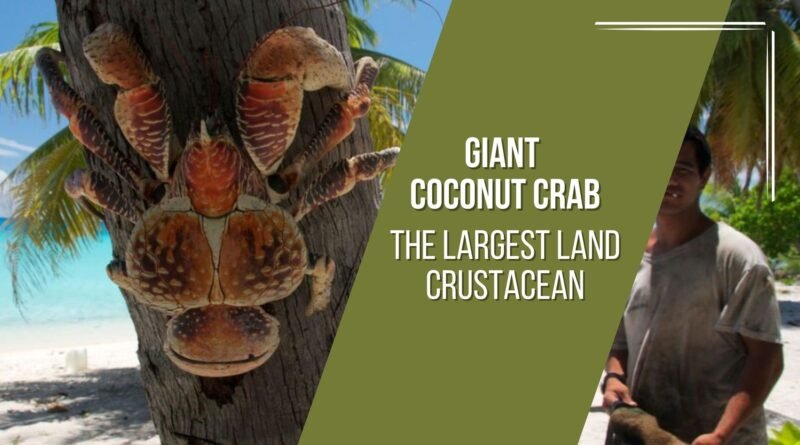Giant Coconut Crab: Meet the Largest Land Crustacean
We’re used to seeing and hearing about marine crab, but did you know that there are around 17 species of crab that only live on land? In this article, we will talk about the biggest of them, the coconut crab giant. It is so large that it is described by some as ‘monstrous’. Let’s meet it! Enjoy reading and have fun!
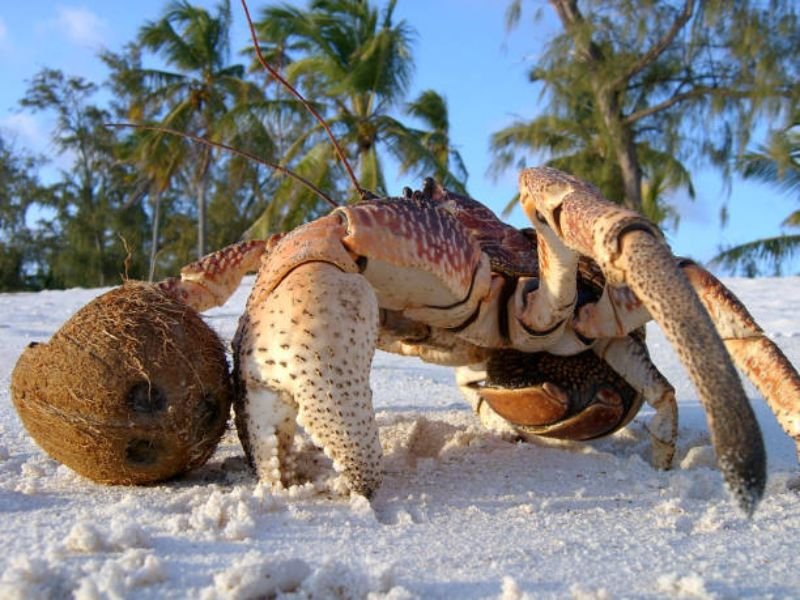
Birgus latro – the origin of the largest land arthropod
“What are arthropods?”, you might ask. Arthropods include several classes of animals, including insects (such as butterflies and ants), arachnids, and crustaceans (such as crab and lobsters), among others. Arthropods are considered one of the most successful and abundant groups in the animal kingdom. They are found in basically all environments, from oceans to deserts and mountains. It is estimated that there are hundreds of thousands of arthropod species described to date, with many more to be discovered.
In general terms, the origin of the giant coconut crab dates back to millions of years ago. It is part of the Coenobitidae family and its ancestors probably evolved in marine environments. It is believed that the transition to a terrestrial lifestyle occurred due to the availability of food resources.
Over many generations, the adaptive traits that made terrestrial life possible for these crustaceans developed until they reached the ones we know today:
• its incredible ability to climb trees, especially coconut trees, hence its name;
• the highly accurate sense of smell that allows them to locate food over long distances;
• post-hatching development: the coconut crab giant lays its eggs in the sea and after hatching, they migrate to dry land, where they develop into adult crab;
• camouflage: the color of its carapace can vary between shades of brown, orange, and red, and this allows the giant coconut crab to hide among the leaves and vegetation where it lives.

Habitat of the Giant Coconut Crab
The giant coconut crab needs access to the sea, as it occasionally returns to it to lay its eggs, remember what we mentioned above? There is another requirement for its place to live: access to fresh water. That is, the ideal habitat for the coconut crab giant combines land areas close to the coast and the availability of fresh water for drinking.
Such sites are found on many tropical islands in the Indian Ocean and the Pacific Ocean, in coastal regions and forests close to the sea. They prefer dense vegetation, scrublands, and mangroves.
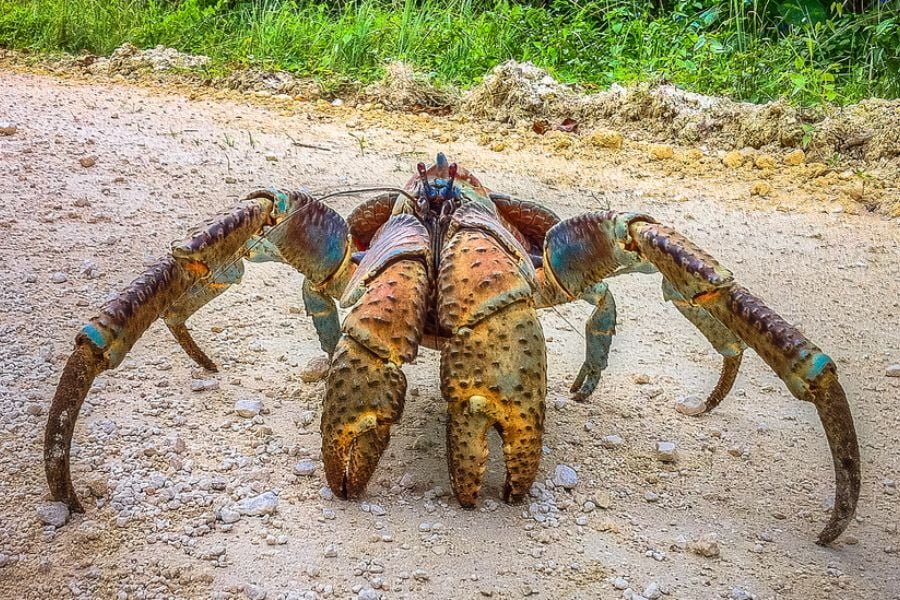
Features
All species of crab, whether marine or terrestrial, share some physical features, including the carapace, compound eyes, and ten legs. However, as we are talking in this article specifically about coconut crab giant, below is a list of features that make this species remarkable:
Carapace
Most of the body of the Birgus latro is covered by its carapace which can vary between shades of brown, orange, red, and even purple. The specific color depends on factors such as the age and gender of the crab, its diet, and even the geographic region in which it lives. Environmental factors such as temperature and humidity can also influence color, which is generally used as camouflage to protect against predators.
Eyes
The giant coconut crab’s eyes are called “compound eyes” and are a distinguishing feature of arthropods. These eyes are made up of several individual units called ommatidia.
Each of these units works like a small lens facing a particular direction. Working together, this structure provides the giant coconut crab with panoramic vision and the ability to detect movement in many directions.
The eyes are located on the sides of the head, which allows for a very wide field of vision. This remarkable feature is just one of many that make this land crustacean so fascinating.
Legs
Like all other crustaceans, the coconut crab giant has ten legs, four pairs for walking, and two claws. The latter is usually more developed at the front and used for different purposes, such as climbing, digging, and manipulating food, including coconuts, their favorite food, which they open with incredible ease. The legs are also used to defend against predators. Their legs are adapted for life on dry land and are essential to their survival and success.
Appendages
Birgus latro also has five pairs of appendages located in the mouth area. These appendages serve to capture and manipulate their food and include maxillas, mandibles, and maxillipeds.
Antennae
Antennae are a crucial part of the giant coconut crab’s sensory system. Through them, the birgus latro has the senses of smell and touch, in addition to helping the crustacean to orient itself about space and navigate precisely in the environment in which it lives. Communication is another of the roles that the antennae have: through touches and movements of the antennae, the giant coconut crab can communicate with others of its species, mainly during the breeding season.
Size and Weight
The size and weight of the giant coconut crab are impressive, although it varies according to the geographic region in which they live and their living conditions. Even so, it is the largest land crab known to exist and can measure a wingspan of 40 inches (distance from leg tip to leg tip). Imagine a crab bigger than a kitten!
That’s right, the giant coconut crab can weigh up to 8 pounds, which is the average weight of a cat. Females in this species are usually a little smaller, weighing around 4 pounds or less.

Behavior
In some regions, the giant coconut crab can be found in social groups, especially if there is an abundant food supply. Despite this, the birgus latro has highly territorial behavior and can become aggressive to defend its feeding space.
When they feel threatened, they can retreat into their bodies and use their claws for defense.
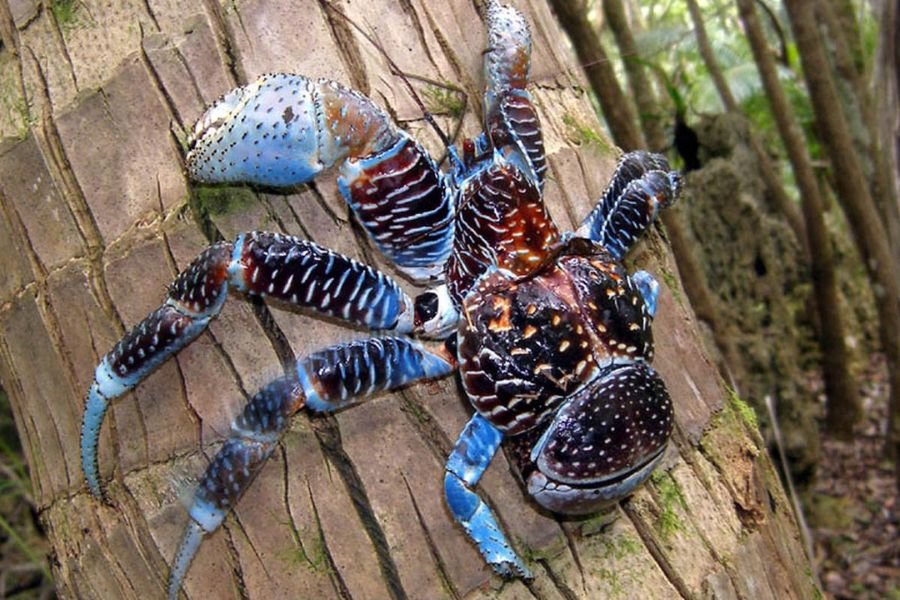
Food
The giant coconut crab is herbivorous, but despite its name, it doesn’t just eat coconut, even though that is its favorite food. Their diet consists mostly of plant material, with fruits such as coconuts and others found in tropical forests. They are attracted to flower pollen and nectar and eat the little flowers as well. Also, there is another lesser-known detail about their diet: depending on the region and the food supply, the coconut crab can feed on meat, especially carrion (they eat dead animals).
However, scholar and researcher at Dartmouth College, Hanover, in the United States, Mark Laidre, recorded in photos the attack of a giant coconut crab on a seagull, behavior never before observed by specialists.
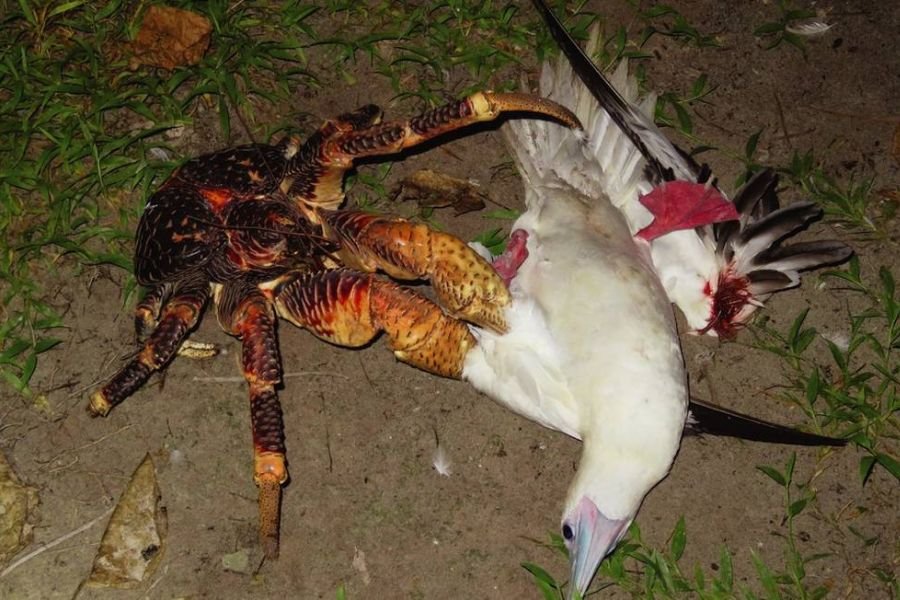
Reproduction
The giant coconut crab reproduction process is one of the most impressive and involves several distinct steps. It all starts with a migration to the sea and, despite being the largest land arthropod, its life begins inside the ocean waters. Interesting contradiction, isn’t it?
Females migrate to the sea and release eggs that develop into larvae called megalopae, in a stage that can last from a few weeks to a month. After this period, the larvae migrate back to land, initiating the glaucothoe stage. At this stage, they find and take a living in some empty snail shells for temporary shelter, and then they become very much like regular crab.
Gradually and under the protection of its shell, it develops the necessary skills to survive on land. Its physical structure also develops during this period, which can last for many months. Upon reaching the adult stage, they abandon the shell and start living near the trees.
Curiosity: after being “born” in the sea, the giant coconut crab never return to ocean water, only for a new reproduction migration.

Conservation Status of the Giant Coconut Crab Birgus Latro
Despite having no natural predators, the giant coconut crab is vulnerable. The reason? Human beings! Yes, we are responsible for this situation. In many places, giant coconut crab are hunted for human consumption and there are reports of animals sold in the illegal exotic pet trade.
Conclusion
Despite being a unique specimen in the world, the largest land arthropod, the giant coconut crab faces the same problem as many other species: the lack of respect and preservation. Talking about the importance of this species may seem redundant, however, letting such an important species for biological diversity disappear is a crime against coastal and forest ecosystems and a huge loss for humanity. Awareness is essential for the survival of these ecosystem engineers, and we count on you to do just that. Know to preserve, always!
Until next time! ♥

